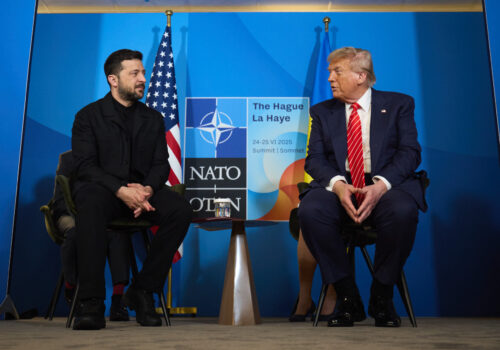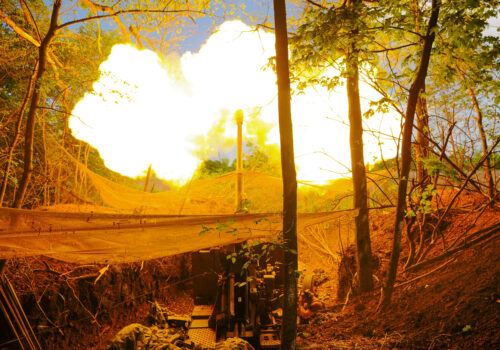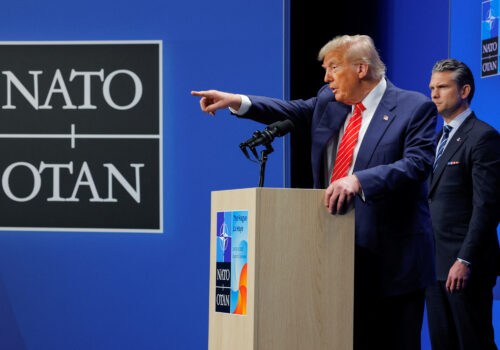Turning on Putin would fit Trump’s trend of second-term wins
It may seem counterintuitive—after years of speculation over US President Donald Trump’s sympathies for Russian President Vladimir Putin—but the logic of Trump 2.0 suggests that a tightening of US screws on Russia would make perfect sense.
In his second term thus far, Trump has defied his critics with several major international wins, and he’s relished the results. His green light for the June 22 US strikes on Iranian nuclear-related targets was a stunning interpretation of what defines “America first.” At the NATO Summit in The Hague days later, he pivoted from years of lambasting European partners to securing a historic agreement to lift Alliance-wide defense and defense-related spending to 5 percent of gross domestic product by 2035, while reaffirming shared security guarantees.
Both the Iran and NATO moves are legacy-defining, peace-through-strength actions. They could transform the geopolitical landscape in the Middle East and Europe in ways that would have eluded either a more cautious or a more reckless president.
The next link in this potential chain of positive disruption should be Russia. There are signs Trump is steering in that direction. It wasn’t too long ago that Trump praised Putin’s peace-making intentions, his smarts, and his strength. Then, this week, Trump said at a cabinet meeting, with media recording every word, “We get a lot of bullshit thrown at us by Putin, if you want to know the truth. He’s very nice all of the time, but it turns out to be meaningless.”
Also this week, Trump reversed a brief pause in weapons shipments to Ukraine, which Secretary of Defense Pete Hegseth reportedly okayed without informing the White House. In the cabinet meeting on Tuesday, the US president praised Ukraine’s soldiers, for the first time putting US investments in Kyiv in a more positive light. The Ukrainians, Trump said, “whether you think it’s unfair that we gave all that money or not, they were very brave, because somebody had to operate that stuff. And a lot of people I know wouldn’t be operating it—they wouldn’t have the courage to do it.”
All that said, a Trump shift on Putin would be consistent with his second administration approach to global affairs.
Trump struck Iran because the risks were low and the opportunity high for US interests in reestablishing deterrence in the Middle East and setting back Iran’s assiduous efforts to gain nuclear weapons capabilities. The strike was also a powerful response to Tehran’s refusal to seriously engage the US president in what he considered a genuine offer of negotiations.
Putin is not taking Trump’s peace-making efforts seriously.
To be sure, Trump’s rhetorical shifts and the unblocking of arms still aren’t the full-throated condemnation Putin deserves. Nor does the current level of US support rise to what Ukrainians have earned holding the line against a self-described US adversary. Better yet would be a more consistent approach to arms deliveries and a tightening of sanctions. On that front, watch closely whether the Senate brings to a vote a far-reaching new sanctions package, one with eighty-four co-sponsors, that only requires Trump’s okay for passage. On Tuesday, Senator Lindsey Graham said that his side of the Congress would “move soon” on his bill. The next day, Senate Majority Leader John Thune said the bill would be on the floor in the coming weeks, while Speaker Mike Johnson said that there’s interest on the House side for more sanctions on Russia because of Putin’s “unwillingness to be reasonable and to talk seriously about brokering a peace.”
As was the case with Iran’s supreme leader, Putin is not taking Trump’s peace-making efforts seriously, and the US president knows it. Even as Trump has worked toward peace, Putin has escalated his killing of Ukrainian civilians. Russia may not be as vulnerable as Iran, but its economy is weak—straining under sanctions—and its people have suffered. More than a million Russian troops have been killed or injured in a war in which Russia has failed to achieve most of its initial ambitions.
There are still important voices in the Trump administration who believe Ukraine should be left to the Europeans because China is the priority. That, however, fails to understand the Moscow-Beijing “no limits” partnership that got us into this war in the first place—not to mention the North Korean troops helping Russia and the hundreds of Iranian drones raining down on Ukraine. Nothing could be more in the United States’ interests than countering this axis of autocratic aggressors, building on the momentum from the strike on Iran. That explains why leaders in Japan, South Korea, and Taiwan have said that the best way to deter Chinese aggression is to stop Putin in Ukraine.
When it comes to the NATO Summit, Trump delivered not because of any nostalgic commitment to Canadian and European allies, who he is at the same time threatening with steep tariffs. Rather, it was because the allies met his price. He could walk away with a “win” both for himself and the American people, reducing US taxpayers’ cost while increasing that of Europe.
At very little risk, turning the screws on Putin would provide Trump further wins at low cost. He could silence those who continue to argue that some tawdry relationship with Russia explains his reluctance to punish Putin. He would further assert US global primacy, adding the reassertion of deterrence in Europe to that in the Middle East. And if bringing peace is motivating Trump, he’s only going to get there by providing Ukraine more leverage for any coming negotiations.
Pulling that off will take a staying power and consistency that will make his second-term accomplishments so far look like a warm-up act. There’s plenty of reason for skepticism. However, those who doubt Trump has it in him haven’t been paying attention to Iran or NATO.
Frederick Kempe is president and chief executive officer of the Atlantic Council. You can follow him on X: @FredKempe.
This edition is part of Frederick Kempe’s Inflection Points newsletter, a column of dispatches from a world in transition. To receive this newsletter throughout the week, sign up here.
Further reading
Tue, Jul 8, 2025
Cautious optimism in Ukraine as Trump vows to send more weapons
UkraineAlert By Peter Dickinson
Ukrainians have welcomed US President Donald Trump’s July 7 announcement that he intends to provide Ukraine with more weapons, but many remain deeply cynical over the longer term prospects for continued US support, writes Peter Dickinson.
Mon, Jul 7, 2025
Why the Pentagon’s ‘pause’ on weapons to Ukraine backfired
New Atlanticist By John E. Herbst
The efforts by the “restrainers” in the administration to pause arms to Ukraine failed. But they are still in the game.
Thu, Jun 26, 2025
Dispatch from The Hague: It’s been Trump’s week in Europe and Iran
Inflection Points By Frederick Kempe
What connects the recent events in Iran and at the NATO Summit is that they won’t be remembered for the threats countered but rather for the opportunities seized.
Image: United States President Donald J Trump participates in a Cabinet Meeting in the Cabinet Room of the White House in Washington, DC Issues on the table include trade and ongoing wars. US Secretary of State Marco Rubio looks on from left. Featuring: Donald J Trump, Marco Rubio Where: Washington, District of Columbia, United States When: 08 Jul 2025 Credit: Aaron Schwartz/POOL via CNP/INSTARimages.com



